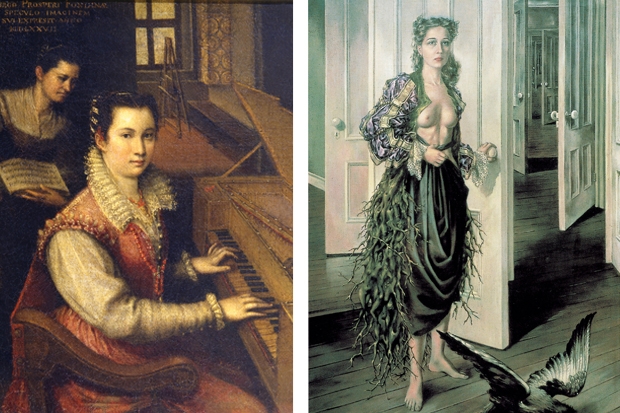At nearly eight foot high and five foot wide, Adélaïde Labille-Guiard’s portrait of herself with two of her students is by any reckoning a tour-de-force. Painted in 1785, it shows the artist seated at her easel, palette, brushes and mahlstick in hand, as though looking up briefly before adding to the large canvas before her. Seated on a gilt and green velvet chair, she is dressed in a pale blue satin décolleté dress and a straw hat decorated with ribbons and ostrich feathers. Her two female pupils stand behind her, one gazing in admiration at the work in progress, the other looking out of the painting, level-eyed and sober.
It is a complex and entirely successful composition on a grand scale: its rhythms convince, its sitters engage with each other and with the viewer, the quality of the painting is superb, the rendering of the satin fabric matches the bravura of the flashiest swagger portrait. It is in the collection of one of the largest museums in one of the most aggressively egalitarian cities in the world, but when you click on the website of New York’s Metropolitan Museum to see in which room this masterpiece hangs, you are confronted with three words: Not on View.
In a sense this is a cheap shot. Museums cannot show everything they own and massive works like Labille-Guiard’s compete for wall space with others equally proficient. Without its display history it is impossible to know how often this painting sees the light of day, but it is perhaps not unfair to see it as part of a long story of the lack of acknowledgment of a whole genre.
That women’s self-portraits constitute a genre is a case forcibly argued by Frances Borzello in Seeing Ourselves, the revised edition of her book first published in 1998. Throughout history the place of women in the art world has been shaped by the social circumstances of their times and in producing self-portraits they have had to rise to challenges and prejudices from which their male counterparts were exempt. ‘An unexpected pleasure,’ Borzello writes, ‘of considering the self-portraits of the past is the information they offer about how it felt to be a woman artist in a man’s world.’ In the 16th century a husband, father or protector was essential to ward off charges of loose living and the self-portraits from this period are predictably contained.

As time progressed, attitudes changed and poses became more relaxed. Judith Leyster in 1633 could portray herself leaning back in her chair and making contact with the viewer over her shoulder. By the 1780s Elisabeth Vigée-Lebrun was producing sexy self-advertisements to show off her skill to prospective clients and collectors. The grip that the male-dominated art establishment had on women’s art education gradually slackened during the 19th century and the advent of the 20th saw the first of the ‘female bohemians’, the heroines, as Borzello puts it, of the modern movement. Rapid change followed and reached some sort of limit with radical feminism in the 1970s, where performance art included activities that more usually take place behind closed bathroom doors.
Borzello charts this shifting perspective with insight and sympathetic intelligence. Occasionally she ‘claims’ as self-portraits works of doubtful attribution, but argues that so many women’s self-portraits are lost or misattributed that it’s only fair to right the balance. She rounds out the better known figures like Sofonisba Anguissola, Lavinia Fontana, Artemisia Gentileschi and Angelica Kauffman, and brings to the fore some largely unfamiliar names. Hortense Haudebourt-Lescot, a French artist, exhibited more than 100 works at the Salon between 1810 and 1840, but neither she nor Anna Dorothea Therbusch, portrait-painter to Frederick II of Prussia, tend to make the index in more general surveys of self-portraiture.
According to the preface, this revised edition includes new research, previously unknown portraits and more reproductions as well as bringing the subject up to date with a discussion of selfies (‘the self-portrait democratised’) and the cross-fertilisation of art and technology. Seeing Ourselves is an essential for anyone interested in the subject and includes a useful biography section at the back. A small quibble — to wrap the outside in a peculiarly nasty dust jacket of salmon pink seems perverse when the inside contains such treasures.






Comments